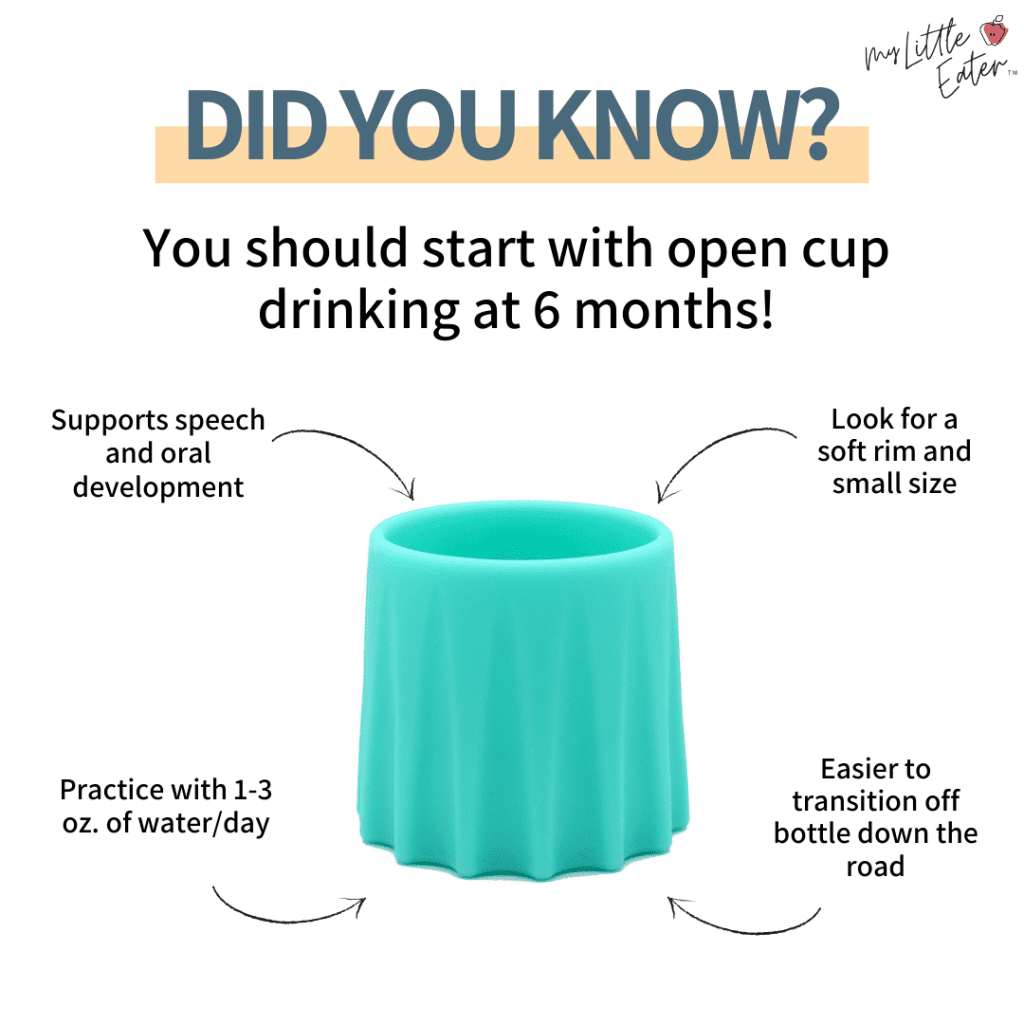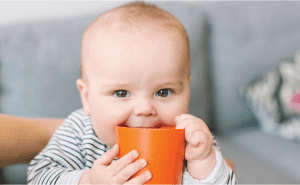Did you know that the first type of cup that should be introduced to baby is an open cup? Not a sippy cup. Seems counterintuitive right? Let’s learn about the reasons why.
When your baby begins solid food, they will begin to need just a little extra water (1-2 oz./day at 6 months) in their diet for preventing constipation and washing down the food at mealtimes. This water is in addition to breastmilk or regular bottle feedings and is usually introduced via a cup at meal/snack times. It’s also a time when they are learning the skill of eating, moving food around in their mouth, drinking from different cups, and babbling and priming themselves for talking…and for this, they need to develop flexible and strong lips, jaw, tongue, cheek muscles and swallow mechanisms…aka oral motor skills!
In my Baby Led Feeding online course, we talk about actually skipping the sippy cup altogether and heading straight for an open cup when introducing water at mealtimes in order to promote these good oral motor skills. You can learn more about the course here.
The reason for no (or very limited use) of a sippy cup is because the skills of using a sippy cup are actually the same ones they would use when drinking from a bottle. Their tongue is placed down and towards the front of their mouth and they suckle to extract the liquid from the spout. And because your baby already knows how to do this, keeping them in a place where they can only use this skill for months and months actually prevents the progression of oral motor skills and can increase the risk of developing delays in speech, difficulty managing textures and even breathing issues.
If you think about a more mature swallow pattern for drinking, the tongue is actually elevated so that it touches the front and top (roof) of the mouth in order to create a wave-like motion to bring the liquid down for a swallow. That’s the skill we want to promote!
That’s why feeding experts of all kinds (dietitians, speech language pathologists, occupational therapists) now recommend introducing water via an open cup beginning at 6 months of age. Just skip the sippy right from the start and head right to an open cup at meal and snack times!
Believe it or not, babies at 6 months of age have the basic oral motor skills to learn how to drink from an open cup, and with help from you and lots of practice, they will be able to control the cup and water spills really well by 1 year of age! In addition, practice with an open cup early on makes transitioning off a milk feedings in a bottle and onto a cup later so much easier! It’s recommended to start transitioning off a bottle at 11-12 months, and it’s not always the easiest transition when your baby isn’t familiar with open cup drinking at all. Always remember that every baby is different and so is every family, so if using a sippy cup occasionally when travelling or on the go, make sure to vary the cup options so they get open cup exposure at most meals and snacks. Also if and when using a sippy, you’ll want to go for a soft spout sippy over a hard spout, as the hard one really prevents the tongue from elevating even more.
What to look for in an open cup
Generally there are two main things to look for when looking for an appropriate open cup for your baby:
-
Soft or semi-soft rim
- The reason for this is because harder rims like those found in stainless steel or glass cups can be hard on baby’s teeth! Sometimes babies can go in for a drink to quickly and can bop their teeth on the hard rim, causing damage (and pain!).
- If possible, go for one that has a soft rim made of silicone so that plastic is avoided and you have a flexible, soft and durable material to work with.
-
Small size for little hands
- Keep cup size small for your baby to wrap their hands around and actually be able to lift and maneuver it to their mouth with ease! I’ve seen baby cups that are pretty much the size on an adult cup or even ones that are made for toddlers that are still hard for baby to manage. Think about if you had to drink out of a bucket of water – it’s hard to do and pretty near impossible not to spill water all over your face and body! It’s pretty much the same thing for babies when they’re given larger cups! It’s also much easier to be able to access just a small amount of water in the cup at at time when it’s a tiny cup (less tilting needed).
-
Other criteria like handles, angled rims, weighted bottoms etc. are all optional.
- Handles definitely help little hands grab onto something especially when they are trying to drink from the cup independently. Although, it’s really not necessary if the cup size is small enough for them. Some cups have angled rims which are nice (like this Doidy cup) which help with not having to tilt their head back so much to get water out. Others even have weighted bottoms to prevent them from toppling over which can be great but also sometimes make it difficult for baby to pick up. All these features are great to experiment and you may find one type works better for your baby than another – but know that they aren’t necessary for your baby to start.

I personally LOVE the Eztotz My First Cup shown above or the EZPZ Tiny Cup (seriously SO cute). They offer all the qualities needed to help teach your baby how to drink from an open cup. Also (especially the tiny cup) is super tiny so it fits well in little hands. They’re made out of soft, soft silicone making it great for protecting little teeth and so easy to clean.
Going with probably the simplest of options, both me and my online course graduates agree that the standard IKEA BORJA sippy cup works great when you just pop the top off and use it as an open cup, as it’s super cheap, has handles and is a great size. This one is made of plastic (BPA free), but do what works for your family!
HOW TO TEACH YOUR BABY TO DRINK FROM AN OPEN CUP
- You’re going to want to start with only a small amount of water in the cup so that there is less to spill, especially when they are just learning in the beginning!
- Help guide the cup to their mouth. You can gently place your hands over theirs and help bring it up to their mouth slowly.
- Tilt the cup up slightly so that the water touches your baby’s lips. We want to promote lip closure around the rim of the cup, so for that, we’ll need to hold the cup there for a couple quick seconds (1 second, 2 second) and then take it away.
- Model cup drinking yourself – pick up a cup, take sip of water and say “AHH” the end to indicate you got your drink!
They may not open their mouth in the beginning or they may making “chewing” motions at first – that’s ok – they will quickly figure out how to open their mouth when water comes in and over time, they will purse their lips enough so that they control the flow of water entering their mouth. They may want to tilt the cup back too far resulting in spill all over them! That’s also ok! Try and not make a big deal out of it so baby doesn’t get upset. In fact, laugh it off and have them try again! It’s fun (and funny) and really…it’s only water!
Check out this adorable video of a sweet baby girl who graduated from my Baby Led Feeding course testing out her cup skills:
How do I minimize spills/mess!
- Practice in the bathtub! They’re naked, surrounded by water and neither you nor baby will be phased by spills.
- Offer water in a cup AFTER meal food, so your baby can focus one thing at a time and you don’t have soggy pieces of toast all over the highchair tray!
What about straw cups?
In short, I love ’em! Mastering a straw cup is another developmental milestone, and by beginning to offer it around 6-7 months old they can get the practice that they need. I teach you all about introducing straw cups, including tips and tricks for teaching your baby how to use them, in my Baby Led Feeding online course!
So are you ready to jump in with open cups? If so and you have any photos or videos of your baby experimenting (or mastering!) the open cup, make sure to either tag @mylittleeater in your stories on Instagram so I can re-share them on my stories, OR send them to me in an email ([email protected]) with permission to share.
Happy cup drinking!






